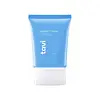What's inside
What's inside
 Key Ingredients
Key Ingredients

 Benefits
Benefits

 Concerns
Concerns

 Ingredients Side-by-side
Ingredients Side-by-side

Ethylhexyl Palmitate
EmollientTridecyl Isononanoate
EmollientCetyl Ethylhexanoate
EmollientPEG-12 Diisostearate
EmulsifyingPEG-20 Glyceryl Triisostearate
EmollientSynthetic Wax
AbrasiveHydrogenated Vegetable Oil
EmollientPrunus Amygdalus Dulcis Oil
Skin ConditioningCandelilla Wax Esters
Phenoxyethanol
PreservativeCitrus Tangerina Peel Oil
MaskingTocopheryl Acetate
AntioxidantAllantoin
Skin ConditioningWater
Skin ConditioningButylene Glycol
HumectantVitis Vinifera Seed Oil
EmollientCaprylyl Glycol
EmollientChamomilla Recutita Extract
Skin ConditioningChaenomeles Sinensis Fruit Extract
AntioxidantGlycyrrhiza Glabra Root Extract
BleachingCopernicia Cerifera Wax
Scutellaria Baicalensis Root Extract
AstringentSophora Angustifolia Root Extract
Skin ConditioningGlycyrrhiza Inflata Root Extract
Skin ConditioningCalendula Officinalis Extract
Skin ConditioningEthylhexyl Palmitate, Tridecyl Isononanoate, Cetyl Ethylhexanoate, PEG-12 Diisostearate, PEG-20 Glyceryl Triisostearate, Synthetic Wax, Hydrogenated Vegetable Oil, Prunus Amygdalus Dulcis Oil, Candelilla Wax Esters, Phenoxyethanol, Citrus Tangerina Peel Oil, Tocopheryl Acetate, Allantoin, Water, Butylene Glycol, Vitis Vinifera Seed Oil, Caprylyl Glycol, Chamomilla Recutita Extract, Chaenomeles Sinensis Fruit Extract, Glycyrrhiza Glabra Root Extract, Copernicia Cerifera Wax, Scutellaria Baicalensis Root Extract, Sophora Angustifolia Root Extract, Glycyrrhiza Inflata Root Extract, Calendula Officinalis Extract
Isododecane
EmollientParaffinum Liquidum
EmollientGlycerin
HumectantEthylhexyl Palmitate
EmollientWater
Skin ConditioningGlyceryl Stearate
EmollientSucrose Palmitate
EmollientSucrose Stearate
EmollientIsomalt
HumectantButylene Glycol
HumectantBetaine
HumectantSodium PCA
HumectantSodium Lactate
BufferingPCA
HumectantSerine
MaskingAlanine
MaskingGlycine
BufferingLecithin
EmollientLycium Barbarum Callus Culture Extract
Skin ConditioningGlutamic Acid
HumectantLysine Hcl
Skin ConditioningThreonine
Arginine
MaskingCallicarpa Japonica Fruit Extract
Skin ConditioningProline
Skin ConditioningPhenoxyethanol
PreservativeBHT
AntioxidantBisabolol
MaskingTocopheryl Acetate
AntioxidantEthylhexylglycerin
Skin ConditioningIsododecane, Paraffinum Liquidum, Glycerin, Ethylhexyl Palmitate, Water, Glyceryl Stearate, Sucrose Palmitate, Sucrose Stearate, Isomalt, Butylene Glycol, Betaine, Sodium PCA, Sodium Lactate, PCA, Serine, Alanine, Glycine, Lecithin, Lycium Barbarum Callus Culture Extract, Glutamic Acid, Lysine Hcl, Threonine, Arginine, Callicarpa Japonica Fruit Extract, Proline, Phenoxyethanol, BHT, Bisabolol, Tocopheryl Acetate, Ethylhexylglycerin
Ingredients Explained
These ingredients are found in both products.
Ingredients higher up in an ingredient list are typically present in a larger amount.
Butylene Glycol (or BG) is used within cosmetic products for a few different reasons:
Overall, Butylene Glycol is a safe and well-rounded ingredient that works well with other ingredients.
Though this ingredient works well with most skin types, some people with sensitive skin may experience a reaction such as allergic rashes, closed comedones, or itchiness.
Learn more about Butylene GlycolEthylhexyl Palmitate, also known as octyl palmitate, is created from 2-ethylhexyl alcohol and palmitic acid. It is a fatty acid ester.
The fatty acid content of Ethylhexyl Palmitate makes it an emollient. Emollients help soften and hydrate your skin by trapping moisture within.
Ethylhexyl Palmitate is also used to help improve the texture of cosmetics. It helps other ingredient dissolve in products and help disperse ingredients more evenly.
You'll likely find this ingredient in sunscreen, as it is often used to mix UV-blocking ingredients such as avobenzone and ethylhexyl triazone.
It can also help stabilize the fragrances in a product as a fragrance fixative.
Ethylhexyl Palmitate can be used to substitute mineral oil.
Due to its high fatty acid content, it may not be fungal-acne safe.
Learn more about Ethylhexyl PalmitatePhenoxyethanol is a preservative that has germicide, antimicrobial, and aromatic properties. Studies show that phenoxyethanol can prevent microbial growth. By itself, it has a scent that is similar to that of a rose.
It's often used in formulations along with Caprylyl Glycol to preserve the shelf life of products.
Tocopheryl Acetate is AKA Vitamin E. It is an antioxidant and protects your skin from free radicals. Free radicals damage the skin by breaking down collagen.
One study found using Tocopheryl Acetate with Vitamin C decreased the number of sunburned cells.
Tocopheryl Acetate is commonly found in both skincare and dietary supplements.
Learn more about Tocopheryl AcetateWater. It's the most common cosmetic ingredient of all. You'll usually see it at the top of ingredient lists, meaning that it makes up the largest part of the product.
So why is it so popular? Water most often acts as a solvent - this means that it helps dissolve other ingredients into the formulation.
You'll also recognize water as that liquid we all need to stay alive. If you see this, drink a glass of water. Stay hydrated!
Learn more about Water